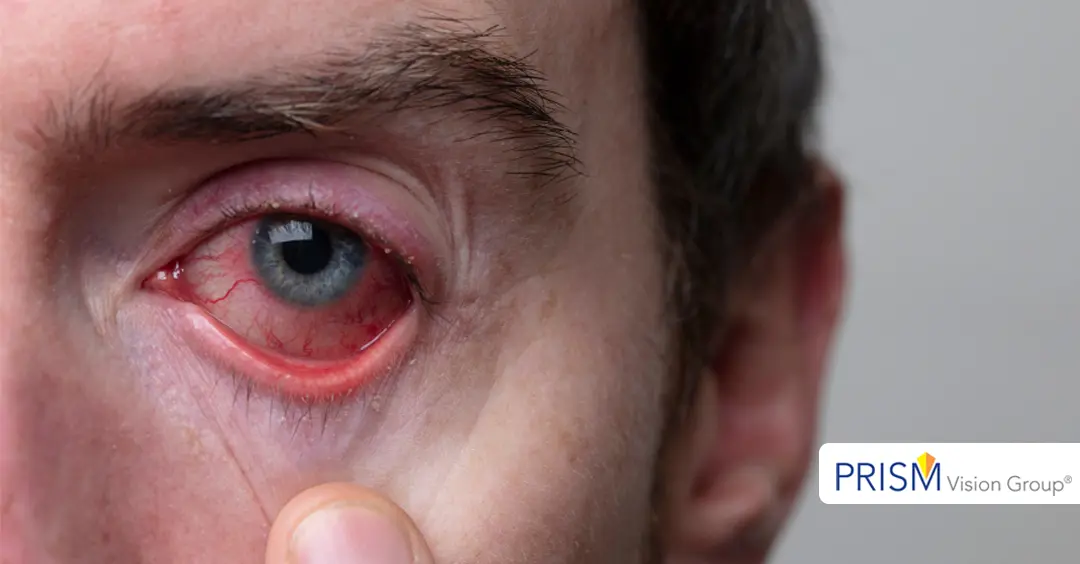While suffering from red, itching, and/or irritated eyes, many of us never hesitate to reach for “Redness Relief Eye Drops.” These drops (the most popular brands being Visine, Clear Eyes, B&L advanced redness relief) are known for temporary relief of minor eye redness or discomfort caused by minor irritants. But what are the ingredients in these drops? And how often should these drops be used without consulting your Eye Associates Physician? Sydney L Tyson, MD, MPH (President and Medical Director of Eye Associates) sends a public service announcement to local communities as his practice has recently been seeing many cases of patients abusing these over-the-counter medications.
“Visine, Clear Eyes, B&L advanced redness relief, and several other generic versions of this redness relief drop most commonly contain either the active ingredient Tetrahydrozoline or Naphazoline. Both of these drugs are in a category called sympathomimetics,” said Dr. Tyson. The problem is that these sympathomimetics work by a process called vasoconstriction (or artificially clamping down the superficial blood vessels on the eye surface.) Blood vessels on the eye surface often dilate in response to irritation of the eye surface. This increase in blood flow is trying to help repair whatever irritation is affecting the surface of the eye. Clamping down on those vessels by using a vasoconstrictor counteracts the body’s efforts to repair the problem.
In short, these eye drops may be fine to use temporarily, but over time they really prevent your eyes from naturally recovering from whatever is causing the irritation in the first place.
“The other downside to repetitively using redness relief drops is that after the vasoconstrictor wears off the vessels often dilate to an even larger degree than when the process started. This stimulates you to use yet another redness relief drop. This leads to a vicious cycle of abusing these eye drops without ever consulting a physician,” said Dr. Tyson.
All of these drops carry these same two warnings on their labels: “Do not overuse as it may produce increased redness of the eye” and “Stop using and ask a doctor if: you experience eye pain, changes in vision, continued redness or irritation of the eye condition worsens or persists for more than 72 hours.”
Drop users must heed these drops’ warnings. “These drops were designed to be used for a very short period of time… one to two days maximum. That’s it,” said Dr. Tyson. They are not meant to be used indefinitely. They are certainly not meant to be used daily.
Using redness relief drops if you wear contacts is an even worse idea. If you put the drop in with your contact in, the contact will hold onto the drug and keep it on your eye surface longer thus potentiating the vasoconstriction. Your cornea has no blood vessels in it and it depends on the blood vessels in the conjunctiva, over the whites of the eye, to bring in nutrients and oxygen. The other source of oxygen for the cornea is what it gets from diffusion from the atmosphere and that is also cut down by the presence of the contact lens. The “redness relief” drop combined with the contact lens are now both reducing the levels of oxygen getting to the cornea. Decreased oxygen to the cornea is one of the biggest risks for contact lens related infections including corneal ulcers.
If you are using redness relief drops repetitively you are likely making your eye redness even worse, not better. It is recommended that you see your Eye Associates Ophthalmologist or Optometrist right away that way the route of the problem can be addressed. “In the meantime, as you wait to see one of us, stop using the redness relief drops and replace them with artificial tears. This should help with some of the irritation without making your problem worse” said Dr. Tyson.
But what will happen to the eyes of those using these drops once they stop? Eye Associates warns that after you make the switch, your eyes are initially going to be red as your blood vessels take time to regain their normal vascular tone without the vasoconstrictor clamping down on them. The lubricating drop will actually help repair the damage done by exposure to adverse conditions. This will decrease the inflammatory signals that make the vessels dilate. Although uncomfortable, this will actually be helpful to the surface of your eyes instead of just masking everything by artificially clamping down on your vessels and decreasing the flow of oxygen and nutrients to the front surface of your eye.
“In short, please consult your Eye Associates physician before using any type of eyedrop long term,” warns Dr. Tyson. “It is so unfortunate when we have patients come in with eye problems such as this that are easily preventable.”
Contact your nearest Eye Associates location at 1-800-922-1766 for more information on the seriousness of these redness relief drops or to schedule your appointment with one of our qualified Ophthalmologists or Optometrists who will keep your vision safe and healthy!






